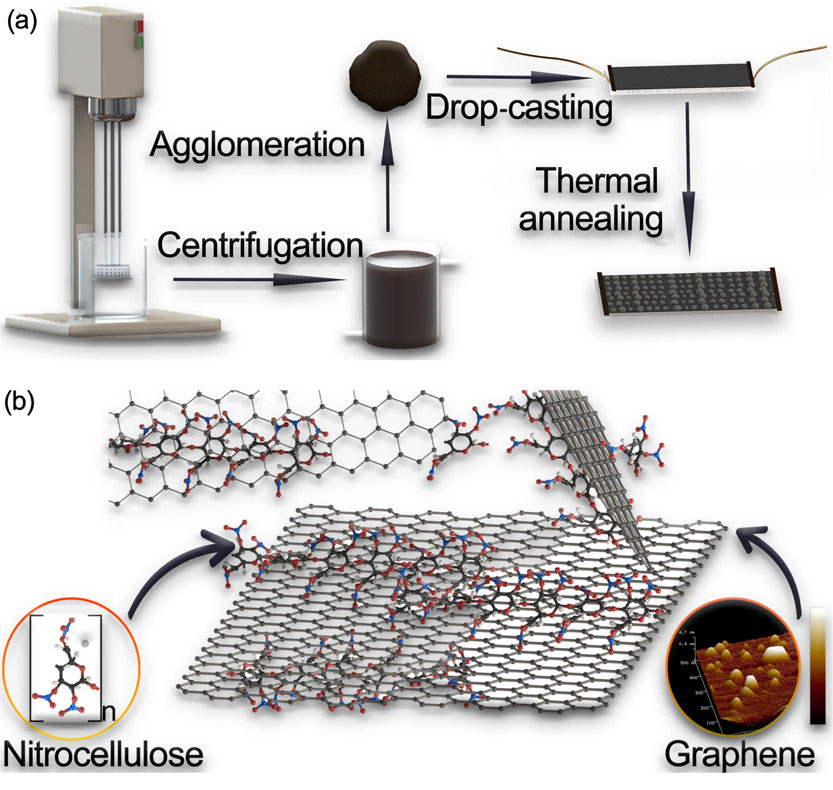| Apr 11, 2022 |
Tunable graphene nanocomposite temperature alarm sensor
(Nanowerk News) Back in 2018, we reported on fire alarm wallpaper that was fabricated using fire-resistant inorganic paper as a coating material based on ultralong hydroxyapatite nanowires and graphene oxide. It was arranged with an electrical connection between the composite paper, an alarm lamp, and an alarm buzzer to achieve an instant response time of less than 2 seconds under a relatively high experimental temperature.
|
|
Materials with low temperature coefficient of resistivity are of great importance in some areas, for example, highly accurate electronic measurement instruments and microelectronic integrated circuits.
|
|
These and similar studies on temperature sensors indicated that graphene and graphene oxide can be used as effective materials for temperature alarm sensors due to their high electron mobility, superior thermal conductivity, high mechanical properties, and structural stability under high temperatures.
|
|
Most of these studies focused only on utilizing the mechanism of graphene oxide reduction to achieve transformation of the conductive state, not on other graphene-like materials.
|
|
In new work published in ACS Applied Materials & Interfaces ("Tunable Graphene/Nitrocellulose Temperature Alarm Sensors"), researchers integrated the electrical conductivity of graphene and the insulation of nitrocellulose to prepare a
new fire alarm sensor.
|
 |
| Schematic illustration of the (a) fabrication process of graphene/nitrocellulose composite alarm, (b) chemical structure of nitrocellulose and molecular structure of graphene/nitrocellulose composite. (Reprinted with permission by American Chemical Society)
|
|
Although the graphene/nitrocellulose membrane remains electrically insulated in normal condition, it instantly turns conductive at high temperatures: Once encountering a flame attack, nitrocellulose decomposes rapidly at high temperature and induces a distinct transition in its electrical resistance, causing the transformation process of the alarm sensor from being electrically insulated to an electron conductive state
|
|
By connecting a LED alarm lamp to the graphene/nitrocellulose sensor, an ultrafast alarm response and early-fire warning signals under flame attacks or abnormal ambient high temperatures can be fabricated.
|
|
Furthermore, the response temperature and sensitivity of these sensors can be tuned by adjusting the ratio of graphene and nitrocellulose to react in different fire-prone scenarios: each 1% increase in nitrocellulose content leads to a ∼1.8 °C increase in the response temperature.
|
|
Because the nitrocellulose thermal decomposition reacts in instances and requires only heat – where oxygen is an indispensable factor – the alarm sensor is able to work stably in an oxygen-free or vacuum environment.
|
|
The authors conclude that this fire alarm also broadens the applications of chemical-modified cellulose and graphene composites in temperature-induced resistance transition sensors with smart responsive behaviors, which provides a promising concept for its applications concerning public safety in terms of fire risk at high fire risk examinations.
|

 By
Michael
Berger
– Michael is author of three books by the Royal Society of Chemistry:
Nano-Society: Pushing the Boundaries of Technology,
Nanotechnology: The Future is Tiny, and
Nanoengineering: The Skills and Tools Making Technology Invisible
Copyright ©
Nanowerk LLC
By
Michael
Berger
– Michael is author of three books by the Royal Society of Chemistry:
Nano-Society: Pushing the Boundaries of Technology,
Nanotechnology: The Future is Tiny, and
Nanoengineering: The Skills and Tools Making Technology Invisible
Copyright ©
Nanowerk LLC
